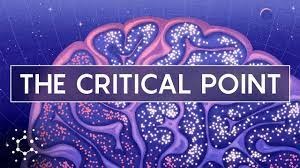John Beggs in Quanta Magazine:
 Over the last few decades, an idea called the critical brain hypothesis has been helping neuroscientists understand how the human brain operates as an information-processing powerhouse. It posits that the brain is always teetering between two phases, or modes, of activity: a random phase, where it is mostly inactive, and an ordered phase, where it is overactive and on the verge of a seizure. The hypothesis predicts that between these phases, at a sweet spot known as the critical point, the brain has a perfect balance of variety and structure and can produce the most complex and information-rich activity patterns. This state allows the brain to optimize multiple information processing tasks, from carrying out computations to transmitting and storing information, all at the same time.
Over the last few decades, an idea called the critical brain hypothesis has been helping neuroscientists understand how the human brain operates as an information-processing powerhouse. It posits that the brain is always teetering between two phases, or modes, of activity: a random phase, where it is mostly inactive, and an ordered phase, where it is overactive and on the verge of a seizure. The hypothesis predicts that between these phases, at a sweet spot known as the critical point, the brain has a perfect balance of variety and structure and can produce the most complex and information-rich activity patterns. This state allows the brain to optimize multiple information processing tasks, from carrying out computations to transmitting and storing information, all at the same time.
To illustrate how phases of activity in the brain — or, more precisely, activity in a neural network such as the brain — might affect information transmission through it, we can play a simple guessing game. Imagine that we have a network with 10 layers and 40 neurons in each layer. Neurons in the first layer will only activate neurons in the second layer, and those in the second layer will only activate those in the third layer, and so on. Now, I will activate some number of neurons in the first layer, but you will only be able to observe the number of neurons active in the last layer. Let’s see how well you can guess the number of neurons I activated under three different strengths of network connections.
More here.
